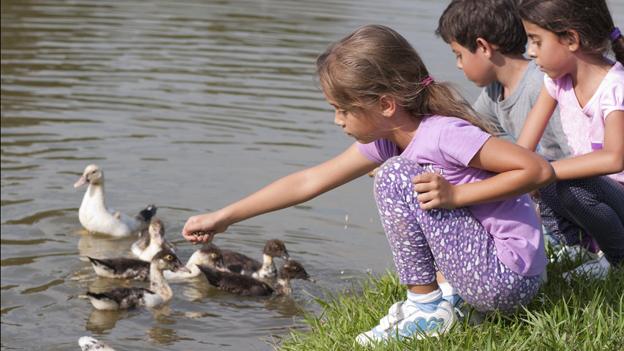The perils of feeding bread to ducks
- Published

It's a seemingly innocent pastime. But experts warn that feeding ducks bread is not just bad for the bird's health - it can damage entire ecosystems, says Justin Parkinson.
Throwing crumbs of stale bread in a pond or river is a ritual of family days out dating back to at least the 19th Century. Ducks vie with geese, swans, moorhens, sometimes gulls, for their fill.
It's long been recognised that a bread-rich diet - particularly processed white bread - can cause wildfowl to become ill and, in some cases, deformed, external. Now conservationists are warning, external that undigested bread sinking and rotting can create wider havoc.
The Canal and River Trust, external says that it can encourage bacteria and algae which can poison other species as well as attracting vermin.
Rotting bread exacerbates naturally occurring surface algae, external - which can give off toxins damaging to fish populations and create a stench for humans - by releasing more nitrates and phosphates. It also denies sunlight to underwater plants. And the bread eaten by birds creates more faeces, which has the same effect.
The nutrients can also encourage filamentous algae, external, which grow upwards from the bottom in chains or threads. The algae can slow down river flows, further deadening the environment.
"Of course, bread's not the only thing that causes the problem," says Richard Bennett, an environment manager at the Canal and River Trust. "It wouldn't matter if you fed ducks in a clear, nutrient-free environment like an upland stream, but people are more likely to do it in towns and cities."
Decomposing bread creates bacteria and attracts vermin, especially rats, whose urine transmits Weil's disease, external, which can be deadly to people.
Wet and rotting bread can be a home for a mould called aspergillus, external, which can get into ducks' lungs, killing them.

But not everyone will want to give up entirely an activity that is popular with children - particularly when it is duckling season.
To prevent excessive build-ups of bread in one area or stretch of water, Bennett recommends dropping only part of the intended feed at one point, then walking 50 metres along the bank or towpath before doing so again. This ensures more than one wildfowl family gets a meal and reduces unnecessary concentrations of algae, bacteria and bird waste.
"Feeding birds is something that people have done for generations and we definitely don't want to discourage that," says Bennett. "But we have to think about how we do it."
Subscribe to the BBC News Magazine's email newsletter to get articles sent to your inbox